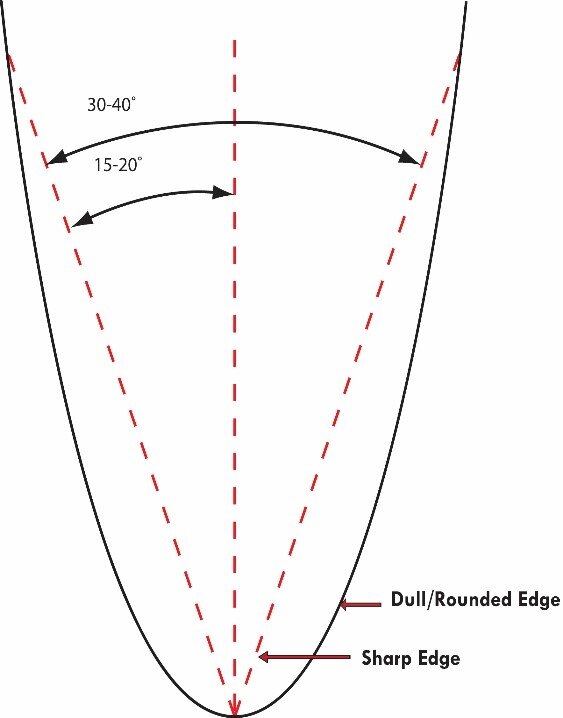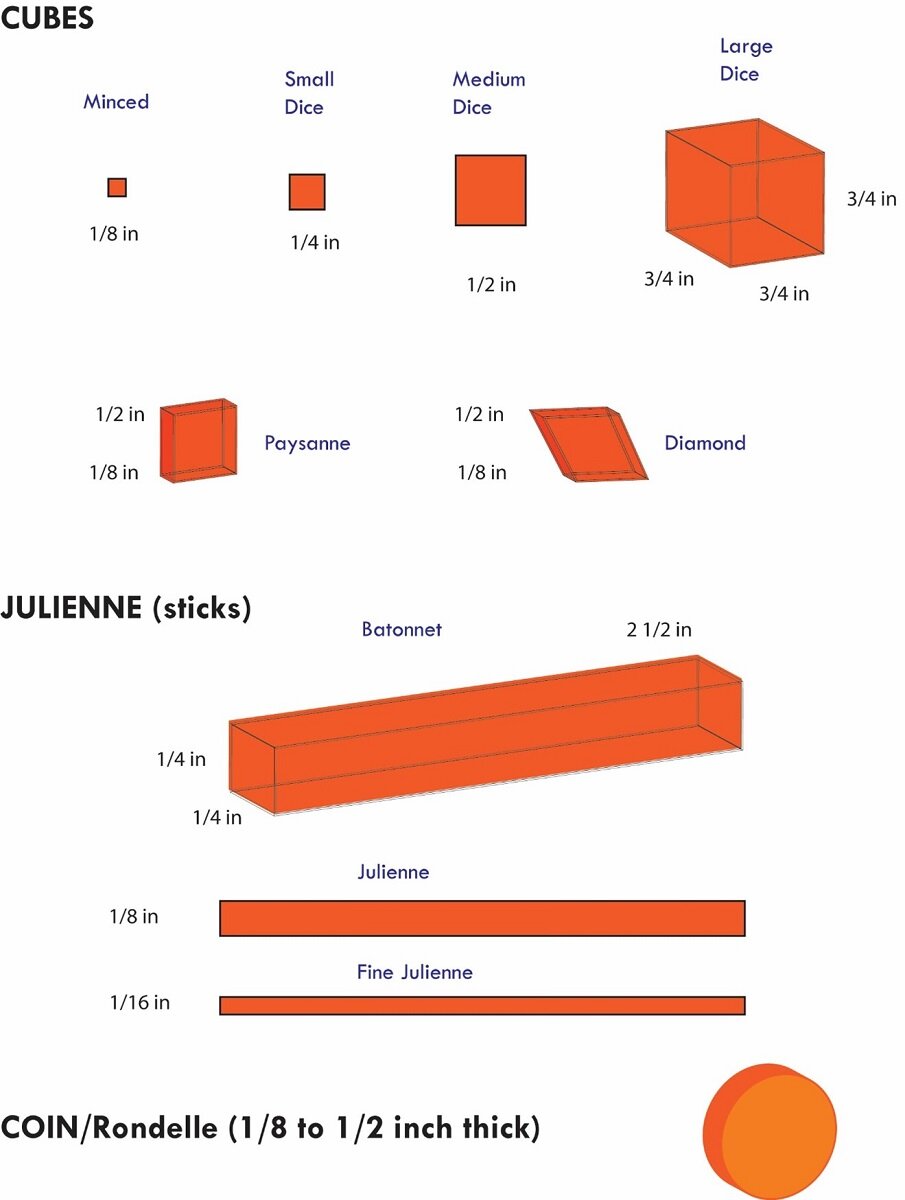Kinds of Knives
The three most important knives to have in the kitchen are the cook’s/chef’s knife, paring knife, and bread knife. Other types of knives, such as boning, filet and slicing, have their uses as you expand your culinary horizons. The following is a little guide to the knives and their uses:
THE THREE MOST IMPORTANT KNIVES
Cook’s/Chef’s– these should be between 6.5-10 inches long and either of a classic French chef’s, Chinese cleaver, Santoku or other Asian style cook’s knife. This will be your most useful/versatile knife. Average edge angle: 15-20°.
Paring– normally these knives are between 2-4 inches long and are perfect for working with small items or doing detailed work. Some come with a hooked blade, called a bird beak or peeling knife, which are especially good for peeling and carving. Average edge angle: 15-20°.
Serrated Bread– the only serrated knife you will ever really need. We’d suggest a 9 or 10 inches, but you can get away with an 8 inches. Bread knives have pointy saw edge to cut through crusty exteriors of breads.
OTHER IMPORTANT KNIVES
Boning- a thin blade averaging around 6-8 inches long, boning knives sometimes have a little flex in the blade. They are great for cutting meat off bones, even the odd shape ones. We find a stiffer blade is more versatile cutting tool. Average edge angle: 10-20°.
Filet- another rather thin bladed knife, normally found between 8-12 inches in length. Most filet knives have quite a bit of flex to them (some can even bend 90˚). This helps with skinning a fish & cutting around their often rounded shape. Average edge angle: 10-15°.
Slicing- this knife does what its name implies and does it very well indeed. Usually between 8-12 inches long, it is perfectly suited to slice; especially cooked meats. This is also a good knife for raw fish if you don’t have a sashimi knife. Average edge angle: 10-15°.
Butcher Cleaver– a knife meant more for smashing (through bones) than cutting. Only if you intent to do your own butchery will this knife come in handy. Average edge angle: 25-30°.
MATERIALS
The most common materials used to make knives currently are:
High Carbon Stainless Steel– these are the good ones. Every manufacturer has a different metal blend (mainly a blend between stainless and carbon steels), but all the higher end ones are of very similar quality. They are tough and will hold an edge for a long time, yet easy to hone and sharpen. They are either forged (folded steel) or stamped. Many stamped blades as just as durable and dependable as the heavier forged knives. Stainless Steel– these mainly are the cheapies you find at Wal-Mart or the grocery store. Avoid these at all costs; the material is too hard (leading to fracturing and chipping) and the price is a reflection of the quality of manufacturing (poor). It might be sharp at first, but once it loses its edge good luck sharpening it.
Carbon Steel- the ones that might be tucked away in your (or grandma’s) drawer or that you see at the flea market; with old riveted wood handles and rusty/tarnished blades. This material was the choice in years past because the metal is soft. It would bend and dull quickly, but sharpen very easily. They are hard to find and difficult to keep in good condition.
Ceramic- these are the ones that look as if they are made of plastic. Ceramic knives are extremely sharp and will hold their edge for a long time, but they are very delicate (i.e. don’t drop it on the floor or it will break). They are well suited for delicate work such as herbs or sashimi.
CARE AND SAFETY
If you properly take care of your knives they should last you most if not all of your lifetime.
Washing:
-
Never wash them in the dishwasher. Not only do they clank around in there, but the high heats and corrosive detergents can be damaging to the metal. Use warm soapy water and let air dry.
Storing:
-
Knife blocks that come apart and are dishwasher safe are more sanitary than traditional wood blocks.
-
With magnetic racks, make sure that the magnet isn’t too strong. Pulling a knife off that would be dangerous.
-
The plastic knife guards are an excellent alternative. They make knives easy to store in kitchen drawers or travel with safely.
Safety:
-
Never place a dirty knife in the sink. Having a sharp blade hiding under the dish water or a dish even in a dry sink is dangerous.
-
To hand someone a knife, hold the knife by the top of the blade (the spine) and hand them the handle.
-
To walk around with a knife, it’s like little kids with scissors; blade pointed down and at your side. It’s also a good idea to let others know that you will be walking near them with a sharp object (a good ‘ol, “Sharp Behind”, never hurt).
HONING AND SHARPENING
Maintaining the proper cutting edge on your knives will make all of your prep work easier and faster.

Honing- Before you start cutting tasks, or anytime during them that your knife isn’t cutting as efficiently, you should hone. Honing doesn’t sharpen your knife; it actually keeps the edge straight and true along with putting a micro-serration on the edge. This micro-serration is the most versatile edge for a knife to have. The smooth steels give a knife a super fine serration, the diamond steel gives a coarser serration. Fine serrations are good for softer materials (such as herbs, meats) and coarse is good for harder materials (such as carrots, squash). Honing should be done on the entire blade length from the back to the tip. Holding the
steel with the tip on the cutting surface; swipe the knife in an arch at a 15-20˚ angle (or whatever angle the knife is sharpened to). Repeat this 6-12 times on each side of the knife.
Sharpening- this should be done only when honing doesn’t fix the edge any more. This usually happens about every 6-12 months. Professional knife sharpening service, carbide edge restorers, sharpening stone and other non-electrical draw through sharpeners can be used. All other devices either take too much skill to use or are of poor design and engineering.
HOLDING KNIVES
Holding a knife correctly will not only increase your safety, but also make cutting much easier and efficient. The most effective way to hold a knife is with a pinch grip:
-
With your index finger and thumb, pinch the blade right where it meets the handle.
-
The fingers can be either a.) flush to the blade, b.) flared out, or c.) a combination of both.
-
Wrap the remaining three fingers around the handle, locking your middle finger securely against the back end of the blade.
THE “CLAW”
The claw is used to protect our other hand and to help guide the knife while cutting. You should be looking in front of the blade when using a knife to accurately line up the next cut, so as to keep them of a uniform size. Utilizing the claw will not only keep your hand safe from the razor sharp edge of the blade, but also help stabilize the knife for a more precise cut.
-
Grab onto something spherical such as an orange or an onion, like your hand was a claw.
-
Remove the object, keeping the claw shape to your hand.
-
Place the claw down (on your fingertips) on top of the food to be cut, keeping your first knuckle flared out just in front of your fingertips. No matter the size of the claw (large, medium, or small), the fingertips are tucked just behind the first knuckles.
-
When cutting vertically: Place the side of the blade against the first knuckle of one or more of the fingers of your claw hand.
-
When cutting horizontally, place the small claw on top of the food, well out of the travel path of the blade.
OTHER TOOLS
You need more than just knives to cut objects efficiently and effectively.
-
Cutting Boards- these should be made of one of only the following materials: wood, plastic, or rubber. The material you cut on should be softer than the material of your knife (ex. no glass, Corian, etc.). A good smallest size to have is 12×18 inches; any smaller is usually too little to handle day-to-day cutting tasks. To mount a cutting board down so that it doesn’t slide around, place either a damp kitchen towel or some damp paper towels underneath the board.
-
Bench Scraper- great for picking up cut items to transport to the pan or prep bowl. Also good for cleaning up cutting surfaces; it can “scrape” gunk up easily.
-
Prep and Scrap Bowls- prep bowls are for the good stuff & the scrap bowl is for the junk pieces. They help keep your cutting station clean & organized.
Damp Folded Kitchen Towel- perfect for wiping off your knife, cutting board, hands, etc.
BELOW IS A COMPLETE VIDEO ON THE BASIC KNIFE SKILLS. ENJOY.
CUT SAMPLES BELOW

